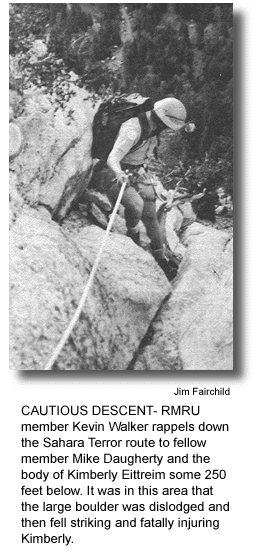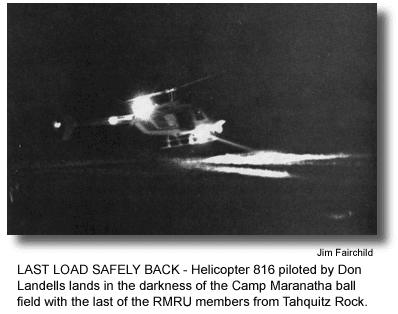Woman struck by rock fall
|
May 27, 1984 |
 |
By Kevin Walker
Rock fall, we all know about most of us have seen, and some of us have been struck by it. It touched home on this particular day. We received a call for a rescue on Tahquitz Rock. The initial report to the Sheriff from bystanders at Humber Park was that a large amount of rock fall was seen and heard, followed by calls for help on the rock.
Enroute to Humber Park I wondered what we would be required to do. Would there be many injured, would there be fatalities. Traffic was in my favor and soon I was at Humber Park. There, emotions ran high. Stories of what happened varied, location of the rock fall also varied greatly. A climber who had been at the base of the rock, hiked back out to Humber. He stated that after the rocks stopped and dust settled he made voice contact with climbers in the fall line. They yelled down that a young woman was struck by a rock weighing in excess of 600 pounds, and was fatally injured by it. No other injuries were reported.
 It was now about 6:30 p.m. Because
of fading daylight it was decided we needed. the
help of a helicopter and one particular pilot,
Don Landells. Don was involved in a rescue in the
Palm Springs area but would be able to break away
to help us.
It was now about 6:30 p.m. Because
of fading daylight it was decided we needed. the
help of a helicopter and one particular pilot,
Don Landells. Don was involved in a rescue in the
Palm Springs area but would be able to break away
to help us.
We moved down to Camp Maranatha and quickly prepared ourselves. Don would only be able to stay a short time, so we needed to make the few flights in count. First load, Mike Daugherty and Walt Walker. Two; Glenn Henderson and myself. Three; Jim Fairchild and Rick Pohlers. With low fuel Don finished the third load and left for Palm Springs to refuel and complete the operation he was involved with. Being the most familiar with the Sahara Terror, Mike was lowered down the route. For the most part, the route is a series of large crack systems. Along the way he passed where the original boulder was dislodged by the lead climber. With approximately 275 feet of rope out Mike arrived at the ledge. After radioing up to hold tension on the line, there was a brief silence and then the message to secure the rope and send me down with the necessary equipment for a body evacuation. Not much was said as people went about their tasks. With gear loaded, I clipped in and began the long rappel as the light of day Began to fade to darkness. I arrived at the ledge and found Mike waiting for me. On the small ledge, about a foot to two feet in width, off to one side lay the body of 23 year old Kimberly Eittreim. Evacuations are never enjoyable and are quite often sad. In this case it was worse, and was therefore quite emotional for me. The small ledge offered little protection from rock fall, and I am sure Kimberly had no time to react when the large rock was dislodged, fell and struck her right shoulder, pulling the arm from its socket and also amputating the right hand. The rock struck her cleanly leaving no other obvious injuries to her body. But by the amount of blood down the face of the rock, it was quite obvious that Kimberly bled to death in seconds.
For some reason there had been a large amount of rock fall in this area all day according to climbers who were on the rock or in Humber, and because we felt that the danger still existed, we opted for a plan that we had only talked about in the past for Tahquitz Rock. I will explain. It was now after 9:00 p.m. and quite dark. Distance and depth changed. The rock seemed so much larger now, with Humber Park being that of small lights of cars driving far below us. Mike and I had placed Kimberly's body into a body bag and then into the aircraft cargo net. Once secured, we took our places and waited for what was only a short time but seemed longer as emotion ran high. Soon we heard the sound of the Bell jet Ranger III. With the helicopter head set on I radioed to Don, he approached us slowly as I talked to him and Mike used red tipped flashlights to help with artificial horizon. This was only a practice run but very important. As Don flew down to base to have RMRU's 80 foot cargo rope attached, I thought of what it is like to fly in the mountains during darkness. I have only been on board several times but could vividly remember how strange it was to have no lights below or in front of you. Soon Don returned, and it was time to do my job. Again Don ever so slowly approached the rock. With a small light taped to the end of the cargo rope for my reference I called out instructions to the pilot above. Because of poor rotor clearance Don had to back away. Because of the shape of the rock Don told me that he thought we could do it from a slightly different angle. This time Don was able to come in tighter to the face, but again we had a problem. Because of the rotor wash against the rock, the weighted rope was being pushed by air away from the face. I relayed this to Don, and with a smooth movement he started a small oscillation in the rope, and in doing so Mike was able to take hold of the rope, secure it to the cargo net, and then with the transmission of "hooked UP, clear to back away," Don applied more power and slowly moved back out from the rock.
 With sighs of relief, we gathered
our gear and started jumaring back up the rope to
the top of the climbing route. Once up systems
were broken down, gear loaded back into packs,
and then the short climb back to the summit of
the rock. There, Don came back three more times
to the tight helispot, but of course this time it
was dark. But soon we were all back at base. I
would like to just say to the following: Don,
thank you for helping us with a very difficult
operation. I speak for all of us in saying it
would not have been as safely done without you
(thumbs up) there. To my closest friends who make
up RMRU, thanks for being there at the top, and
also to those who anxiously waited and listened
at base. I have been there too and it is not a
nice position to be in. To the sustaining
members, for helping us have the best equipment
possible, thank you. And finally to the family
and friends of Kimberly Eittreim, our deepest
sympathy for the loss of a loved one. As you can
see this is a mission that I will not forget for
many obvious reasons.
With sighs of relief, we gathered
our gear and started jumaring back up the rope to
the top of the climbing route. Once up systems
were broken down, gear loaded back into packs,
and then the short climb back to the summit of
the rock. There, Don came back three more times
to the tight helispot, but of course this time it
was dark. But soon we were all back at base. I
would like to just say to the following: Don,
thank you for helping us with a very difficult
operation. I speak for all of us in saying it
would not have been as safely done without you
(thumbs up) there. To my closest friends who make
up RMRU, thanks for being there at the top, and
also to those who anxiously waited and listened
at base. I have been there too and it is not a
nice position to be in. To the sustaining
members, for helping us have the best equipment
possible, thank you. And finally to the family
and friends of Kimberly Eittreim, our deepest
sympathy for the loss of a loved one. As you can
see this is a mission that I will not forget for
many obvious reasons.